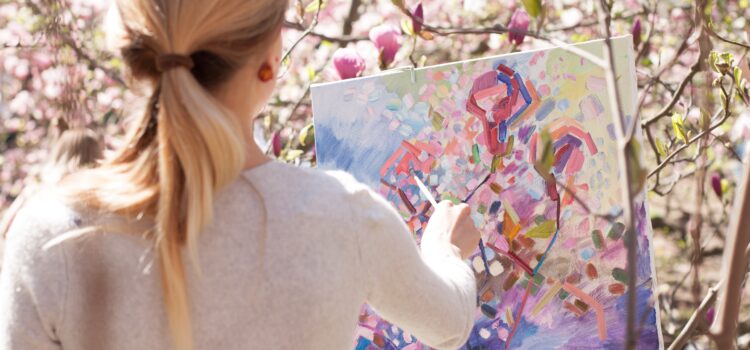

This article is an excerpt from the Shortform book guide to "Show Your Work" by Austin Kleon. Shortform has the world's best summaries and analyses of books you should be reading.
Like this article? Sign up for a free trial here .
Do you want to turn your hobby of creating art into a career? How can you promote your art online?
Making art is fun and exciting, but it can be a little difficult to get your work recognized. Artist Austin Kleon has a few tricks that will help get your work out there for the world to see.
Here’s how to promote art online from Kleon’s book Show Your Work!.
How to Promote Art Online
Kleon offers specific insights on how to promote art online. He recommends first and foremost engaging with social media platforms to showcase your creative process and help people find you. In addition to social media, he recommends having your own website. Here we’ll explore specific ways you can start sharing your work online.
(Shortform note: In the time since Show Your Work! was published, numerous studies have found that social media has profoundly negative effects on mental health. Kleon’s advice to use social media as a primary means of sharing your work should be considered with this in mind. It’s still valuable for advancing your creative career—in certain fields, such as the fashion industry, it’s even considered a requirement—but it’s important to monitor its impact on your well-being. One study found that limiting social media use to 30 minutes per day can significantly improve your mental health.)
1. Make Sharing a Habit
Kleon advises you to make sharing a habit, preferably a daily one. A practical way to do this is to post on a social media platform such as Instagram, Tumblr, or Youtube every day. He encourages you to try out new platforms as they emerge—if you find something that works for you, stick with it. Whatever platform you use, make time to do it daily. Regular posts generate a steady stream of content for people to see, which creates more opportunities for people to connect with you.
2. Document Your Progress
Before you can start promoting art online, you must gather material, claims Kleon. A way to do this is to simply document your work. Use your smartphone or some other device to record what you’re doing at any stage in the process. Not only will such photos and videos serve as material to post online, but they’ll also help you study your methods and develop your skills and techniques.
According to Kleon, posting to your blog or sending an email to your subscribers are also effective ways to share on a regular basis, and they give you even more control over the content. For instance, certain social media platforms limit the number of characters you can use in a post. By contrast, in a blog post, you can write as much as you want. Consider adding blogging and emailing to your routine.
3. Give the Context Behind Your Work
Posting your work daily is good, but if you post without providing any explanation—no context or backstory, for instance—you’ll be missing out on the opportunity to engage people even more, claims Kleon. He suggests that this is because people tend to value things based on their understanding of the context of those things. For example, if you bought a marble bust from a thrift store and later found out it was an ancient Roman artifact, your opinion of its value would probably change.
Contextualizing your work is a matter of crafting a story, according to Kleon. This isn’t a skill that comes naturally to everyone, so he suggests you follow good examples: fairy tales and myths, for instance. Such stories have a problem, work done to solve that problem, and a solution. More basically, they have a beginning, a middle, and an end.
For example, tell people about the sunrise you saw on the way to your office or the hours of research invested before finally discovering the one resource you’ve been hunting down for days. When you finally publish your book, followers may be more inclined to get a copy since they know how much labor went into it.
(Shortform note: Communication experts offer several tips for telling a good story. One particularly useful idea is to start with the message. That is, figure out exactly what point you want to make before you start crafting your narrative. For instance, if you hope to convince people to listen to your new song, you might consider telling them about the quirky instrument you found during the recording session that ended up making it into the release. Once you have that point nailed down, it becomes easier to put together the story that will help you make that point.)
4. Have Your Own Website
As important as it is to post and contextualize your work on social media, having your own website gives you more control and an even better way to promote art online. Kleon is adamant that you should have one. If you don’t already have one, buy a domain name and build a website (or have it built). Fill that site with your story—your interests, thoughts, products, and so on. Even if people don’t visit your site now, if you keep up with it, you’ll be ready for people to find it when the time comes.
Kleon attributes most of his success to his blog on his website. For years he posted pictures of his illustrations, poems, thoughts, and ideas there. These were the bits of content that got him found. For him, a website allows people to learn about you regardless of social media trends, which are always changing.

———End of Preview———
Like what you just read? Read the rest of the world's best book summary and analysis of Austin Kleon's "Show Your Work" at Shortform .
Here's what you'll find in our full Show Your Work summary :
- How to succeed at your creative endeavors
- How to make money off your creative work
- Why you should share your creative process






